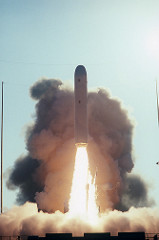Last night the Huffington Post released a draft version of the Trump administration’s Nuclear Posture Review, a deeply dangerous document that makes nuclear war more likely. UCS has a press statement on the draft, and below is a compilation of some additional quick thoughts on the draft, with more to come.
+ + + + +

The Trident II D5 missile
The Trump NPR calls for a new, low-yield warhead for the Trident submarine-launched missile. The NPR premises the need for that warhead on the idea that the following systems will not be able to penetrate enemy air defenses to attack enemy targets:
- US dual-capable aircraft—including the new F35A stealthy fighter aircraft—armed with gravity bombs, including the new, high precision, low-yield B61-12;
- The dual-capable aircraft of allied countries in Europe that currently host US nuclear weapons;
- US B-2 stealth bombers armed gravity bombs, including the new B61-12;
- US B-52 bombers armed with air-launch cruise missiles and the future long-range standoff (LRSO) cruise missile, and
- the future B-21 “Raider” stealth bomber armed with gravity bombs and cruise missiles.
Seriously?
If that is the case, why are we spending hundreds of billions of dollars to deploy new stealthy nuclear-capable fighter aircraft and bombers, new gravity bombs, and new cruise missiles? The NPR calls for an unrealistic spending spree that is not justified by security needs.
+ + + + +
The Trump NPR significantly reduces the threshold for the use of nuclear weapons by explicitly listing a wide array of non-nuclear attacks on the United States that could constitute grounds for a US nuclear response, including attacks on civilians, infrastructure, nuclear forces, command and control, and early warning systems.
This is a dramatic change from the Obama administration’s nuclear policy, which explicitly sought to limit the roles and purposes of US nuclear weapons. It also reverses the trend of every administration since the end of the Cold War, Republican and Democratic alike. The Obama NPR set as a goal declaring that the sole purpose of US nuclear weapons is to deter a nuclear attack on the United States, its military forces, and its allies. It wanted to make nuclear war less likely. This document explicitly rejects that goal and in doing so makes nuclear use more likely.
The NPR also calls for tighter integration of nuclear and conventional forces. That deliberately blurs the line between the two and eliminates a clear nuclear fire break.
+ + + + +
The Trump NPR reverses the plan to retire the B83, a gravity bomb with a massive 1.2 megaton yield—by far the largest in the current US stockpile. Because the military had little use for this Cold War behemoth, the Obama administration had pledged to retire the B83 as soon as confidence was gained in the new B61-12 bomb, as a way to build support in Congress the for new B61. This document says it will keep the B83 “until a suitable replacement is identified.” That could be the B61-12, but there is no commitment to it.
+ + + + +
This document returns to the tired and inaccurate concept of “gaps” in US capabilities that ostensibly require new weapons systems to fill. President Kennedy campaigned on the idea of a “missile gap” when in fact it was the United States that had many more missiles than the Soviet Union. The document points to the “gap” in low-yield options that drive the need for new systems. But there is no “gap.” The US has multiple systems on multiple platforms able to deliver low-yield weapons.
+ + + + +
The document argues that Russia and China are modernizing their nuclear arsenals, and the United States is not. That is utter hogwash. The United States has been modernizing its forces consistently for the last several decades, but it has done so without building new systems. It has upgraded and improved the systems it already has. For example, a decade ago the United States still had submarines armed with Trident C4 missiles, which were not very accurate. Now, not only does every submarine carry the D5 missile, accurate enough to attack hardened targets, but those missiles are being updated, with newly built motors and improved guidance systems making them even more accurate. The W76-1 warheads on those missiles have also been improved, further increasing the ability to hold hardened targets at risk. And that system comprises the bulk of the US nuclear stockpile.
It’s also important to recognize that China’s nuclear arsenal remains tiny in comparison to the US arsenal. The United States has more than 1500 strategic warheads on three types of delivery systems. China has well fewer than 100 warheads on missiles capable of reaching the United States, and the warheads are not even mated to the missiles. They are fully de-alerted. There is zero comparison to US forces.
